Indice - Table of contents
New Stuff[hide]
Reportes: From The St... : Cubadisco 2...
Fotos: Tom Ehrlich
Staff: Kristina Lim
Musicos: Juan Formell
Musicos: Yordamis Megret Planes
Musicos: Yasser Morejón Pino
Musicos: José Luis "Changuito" Quintana...
Musicos: Dennis Nicles Cobas
Fotos: Eli Silva
Grupos: Ritmo Oriental : 1988 - Vol. IX - 30 a...
Musicos: Rafael Paseiro Monzón
Musicos: Jiovanni Cofiño Sánchez
Fotos: Tom Ehrlich : 2024 Monterey Jazz, P...
Resenas: Vacilón Santiaguero (Circle 9 ...
Photos of the Day [hide]
Discography - The 1970s
The 70s: As the 70s turned around, Guaco started experimenting with new sounds and insturmentation. Particularly important they added José Baptista "Tantan" formerly of rock group Los Blonder for support and recruitment of new musicians. They added Electric guitar, bass, congas and piano to the standard gaita insturmentation (to the dismay of many gaita traditionalists) and particularly started taking harmonic influences from Aldemaro Romero's Onda Nueva group, with its fusioning of Venezuelan joropo and jazz harmonies, often sung with 4 part harmonies.
1970 - Los Guacos
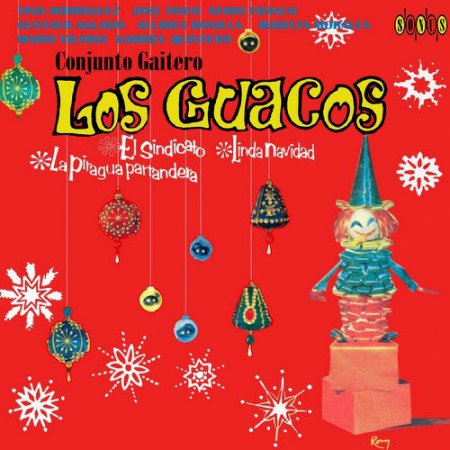
Side A
1. La Piragua Parrandera
2. Gaita Moderna
3. La Reforma
4. Homenaje A Don Armando Molero
5. ¡Y Que Cambio!
Side B
1. Linda Navidad
2. El Sindicato
3. La Tradicional
4. Estampa Matinal
5. Arrimate
6. ¡Qué Situación!
Sadly, we don't have full credits for this album, but Guaco was already making headways in terms of experimentation. This is the first album to feature electric bass (plus a couple of furros adding pressence in the low frequencies), in the second track there's four part harmonies inspired by Aldemaro Romero's Onda Nueva arrangements. The same track also features what sounds like kazoos in lieu of brass.
On the front cover we can see some of the musicians' names: Tino Rodríguez, José Tineo, Nerio Franco, Gustavo Aguado, Alcides Bonilla, Maritza Morales, Mario Viloria and Gabriel Quintero. La Reforma was later re-recorded in 2018, sung by Gustavo Aguado, the original singer.
1971 - Los Guacos
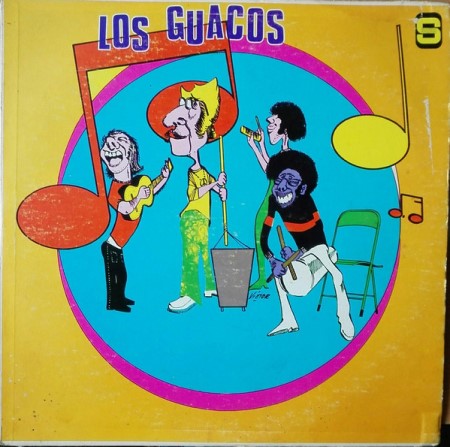
Side A
1. Gaita Nueva (Gustavo Aguado) Sung by: Betty Alvarado
2. Perdóname (José Baptista) Sung by: Gustavo Aguado
3. Esquinita (Gustavo Aguado) Sung by: Alcides Bonilla
4. Aguinaldeando:
a) San Nicolás (Iván Pérez)
b) Cinco Pa Las Doce (O. Oropeza)
c) Doce Campanadas (L. Ferrer)
d) Alegre Navidad (L. Ferrer) Sung by: José Tineo
5. Tierra de Dios (Luis Ferrer) Sung by: Maritza Morales
Side B
1. Dale, Dale (Nerio Franco) Sung by: Alcides Bonilla
2. La Cascada (José Castillo) Sung by: José Tineo
3. Gaita Y Onda (Gustavo Aguado) Sung by: Betty Alvarado
4. Amor es... (Heriberto Molina/Nerio Franco) Sung by: José Tineo
5. Juan José (José Baptista) Sung by: Maritza Morales
6. Petróleo y Agricultura (Mario Viloria) Sung by: Gustavo Aguado
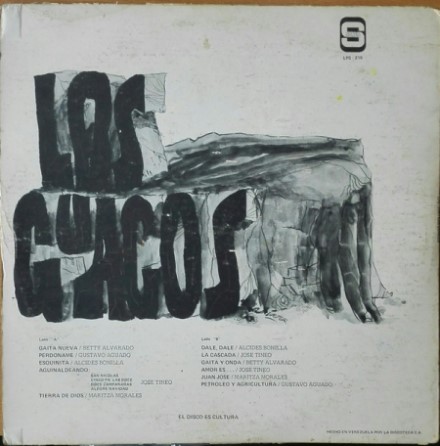
This album is sometimes referred to as "Gaita Y Onda", which must've been a big hit at the time. Gustavo Aguado writes three and sings two. José "Tantán" Baptista was invited by Aguado to get the musicianship in order. He would also design the famous "trident" logo that started on the next album. He had played previously in a rock group called Los Blonder. (Fun fact: Maracaibo was the first Venezuelan city to have rock groups). Perdóname begs the genre itself for forgiveness, because they were adding new instruments and harmonic complexity.
1972 - Esta Gaita Si Está En Algo - CBS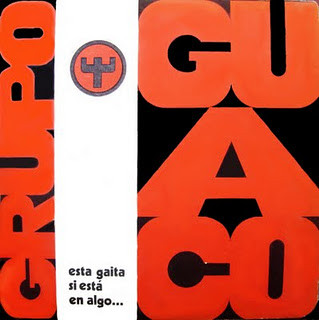
Side A
01- Introducción (Gustavo Aguado)
02- Perdóneme Tio Juan (Alí Primera)
03- Mi Guía (Renato Aguirre/Gustavo Aguado)
04- Camino (Gustavo Aguado)
05- Quiero (José Baptista)
Side B
01- Nuestro Swing (Nerio Franco)
02- La Droga (Mario Viloria)
03- La Sirena (José Tineo)
04- Pasion Indiana (José Baptista)
05- El Calorcito (Mario Viloria)
06- Bubú Guaco (Enrique Salas)
Personnel:
Vocals: Gustavo Aguado (tracks A2, A4, B2, B4)
José Tineo (tracks A3, B1, B3)
Alcides Bonilla (track A4)
Ender Fuenmayor (track A5)
Maritza Morales (track B5)
Argenis Carruyo (track B6)
Cuatro: José Castillo & Nerio Franco
Piano & Guitar: Nerio Franco
Tambora: Eudomar Peralta & Luis Rincón
Furro: Charles Petit & Fernando Dominguez
Charrasca: Ricardo Hernández
Congas: Argenis Carruyo
Bass: Carlos Sánchez
Backing Vocals: Mario Viloria, José Castillo, Maritza Morales,José Tineo, Gustavo Aguado, Alcides Bonilla, Ender Fuenmayor, Heberto Bracho Jr.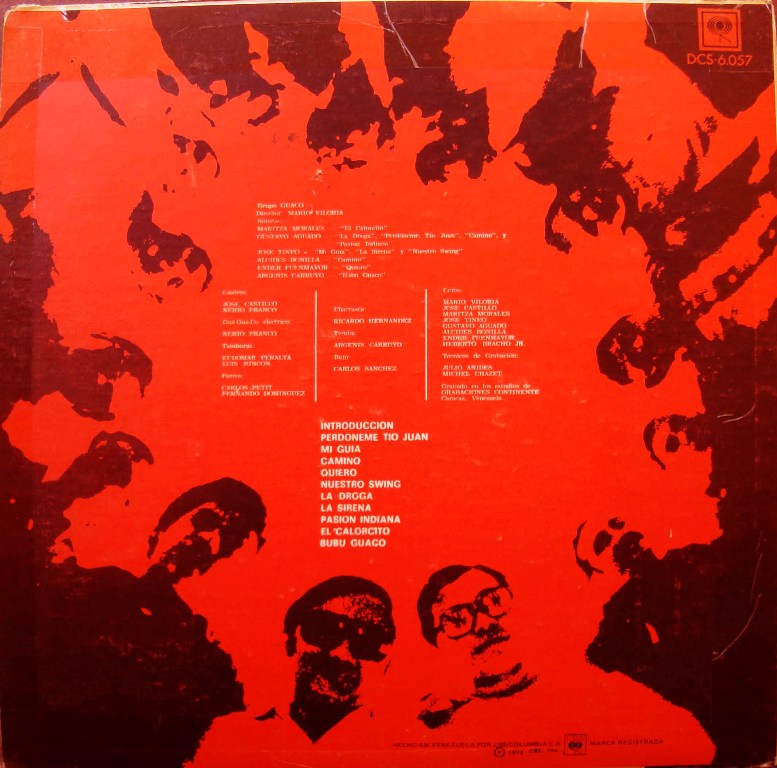
We finally have a full list of members for the album! In 1972 Guaco signed to CBS and they made a significant leap forward with this album. Argenis Carruyo -who would later go on to replace Oscar D'Leon in La Dimensión Latina when he went solo in 1977- adds congas to the rhythm section. Introducción starts with the album with a bang, beginning with a complicated vocal arrangement, plus a healthy dose of echo and flanging guitar, this could only be described as psychedelic gaita. Nerio Franco adds Rhodes Piano to some tracks, plus wah-wah'd guitar to Nuestro Swing. Future musical director Ricardo Hernández plays a masterclass in charrasca throughout the record.
José Baptista gave Guaco one of their most enduring gaitas in Pasión Indiana, which is sometimes played live to this day on special occasions. The band also dabbles in calypso in the last track, Bubú Guaco. It was a big hit at the time. The band would later express remorse at recording Perdóname Tío Juan, a song written by protest singer Alí Primera, due to its pamphlet nature, but it was the sign of the times.
1973 - Bubú Guaco - CBS
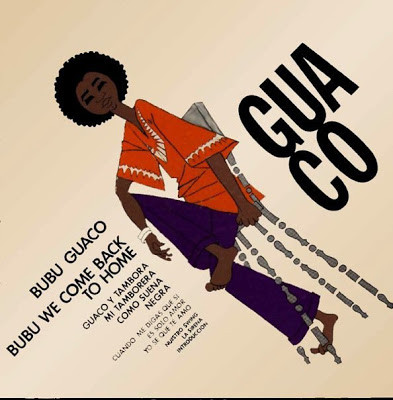
Side A
01- Negra (Ricardo Hernández) S: Argenis Carruyo
02- Como Suena (Ricardo Hernández) S: Argenis Carruyo
03- Mi Tamborera (Ricardo Hernández) S: Argenis Carruyo
04- Introducción (Gustavo Aguado)
05- Cuando Me Digas Que Si (Rafael Hernández) S: Ricardo Herández and Argenis Carruyo
06- Es Solo Amor (Ricardo Hernández) S: Argenis Carruyo
Side B
01- Bubu Guaco (Enrique Salas) S: Argenis Carruyo
02- La Sirena (José Tineo) S: José Tineo
03- Bubu We Come Back To Home (Argenis Carruyo) S: Argenis Carruyo
04- Guaco y Tambora (Ricardo Hernández) S: Ricardo Hernández
05- Nuestro Swing (Nerio Franco) S: José Tineo
06- Yo Se Que Te Amo (Armando Manzanero) S: Gustavo Aguado
It seems that Bubú Guaco was a special enough hit that it was deemed necessary to release this strange hodgepodge of new tunes and songs already released in the previous record. It seems that Ricardo Hernández and Argenis Carruyo were given free rein to try to do whatever they pleased musically.
Nevertheless, it's a significant record too because it marks several milestones. This record features the first appearance of a salsa track in "Negra" very much in the style of La Dimensión Latina, plus also the first versions of two very important tracks: "Mi Tamborera" and "Guaco Y Tambora", both of which would go on to become live staples for the group and would get re-recorded in various ocassions. Also the first album to feature a horn section, a pair of trumpets.
Mi Tamborera is significant enough because it's Guaco's first experimentation with the tamborera rhythm created by fellow gaita group Gran Coquivacoa. The tamborera rhythm is played in 4/4 in contrast to gaita's 6/8, The tamborera beat would become the foundation for Guaco's experimentation with every single other genre they would try their hands at. When they try to meld their sound with rock, jazz or salsa, the tambora and the charrasca are laying down the tamborera beat steadily as ever. The tamborera rhythm also opened the posibilities for Guaco to explore montuno sections at the end of the gaita cuerpos, and they would exploit this technique to their hearts' content.
This album also features 3 attemps at a soul/R&B style tunes, which are interesting but nothing to write home about and lastly, Bubu Guaco's sequel Bubu We Come Back To Home.
1973 - Gaita A Todo Color - CBS
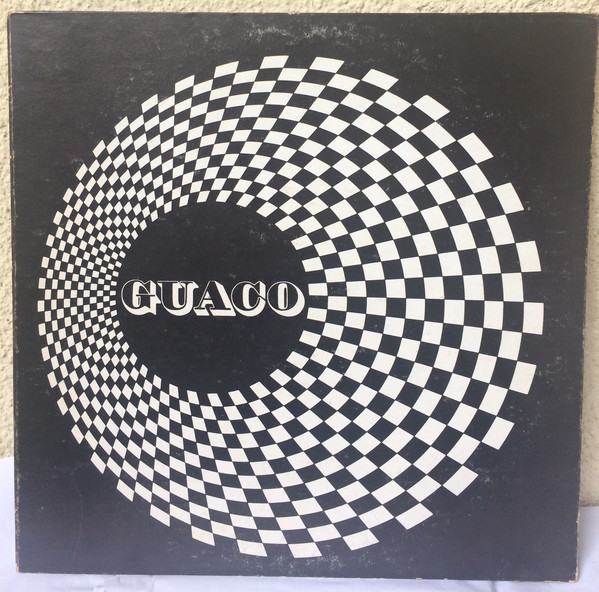
Side A
01- Hay Que Aligerar La Carga (Alí Primera) S: Gustavo Aguado
02- Damele Así (Gustavo Aguado) S: Argenis Carruyo
03- Nostalgia Del Gaitero (Nerio Franco) S: Gustavo Aguado
04- Compai José (Nerio Franco) S: Argenis Carruyo
05- El Tumbao (Ricardo Hernández) S: Gustavo Aguado
06- Paseo Ciencias (Gustavo Aguado) Instrumental
Side B
01- Gaita De Mi Sueño (No Me Importa) (Nerio Franco) S: Argenis Carruyo
02- Golpe Gaitón (José Baptista) S: Gustavo Aguado
03- Gale Galey (José Castillo) S: Argenis Carruyo
04- Quiero (José Castillo) S: Gustavo Aguado
05- La Tambo – Merengue (Nerio Franco) S: Argenis Carruyo
Personnel:
Vocals: Gustavo Aguado, Argenis Carruyo, Edgar Alvarez, Oswaldo Borges, José Castillo, Alcides Bonilla, José Baptista, Ricardo Hernández, Carlos Sanchez
Tumbadora: Argenis Carruyo
Electric Guitar and Cuatro: Nerio Franco
Cuatro: José Castillo
Acoustic Guitar: José Baptista
Charrasca: Ricardo Hernández
Electric Bass: Carlos Sanchez
Tambora: Eudomar Peralta and Luis Rincón
Furro: Carlos Petit and Fernándo Dominguez
Director: Heberto Bracho, Jr.
Recorded in Caracas in Studios del Este
Recording Engineer: Ricardo Landaeta
With its op-art cover and fun title, this is a record with pretentions of modernity and actually, it works. It picks off where 1972's Esta Gaita Si Está En Algo left off. The rhythm section is particularly fierce throughout the record. Probably their most consistent so far. Compai José starts with blazing bpm and changes rhythm midway. La Tambo-Merengue fusions the tamborera rhythm with merengue, as the name implies.
1974 - No Diga Que No Los Ha Escuchado Ni Los Ha Visto - CBS
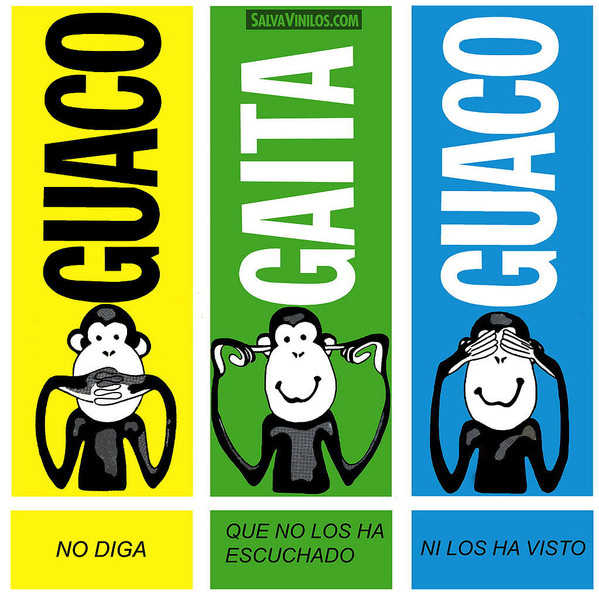
Side A
01- La Gaita Tiene Montuno (Ricardo Hernández)
02- Papá Viejo (Marío E. Valero)
03- La Embajadora (Nerio Franco)
04- Cuatro Imborrables (Humberto Rodríguez)
05- El Vividor (Arturo Carruyo)
Side B
01- Con Gaitas Fue (Humberto Rodríguez)
02- Luis Antonio (Luis Oquendo Delgado)
03- Parranda Fiestera (Nerio Franco)
04- El Niche Parrandero (Nerio Franco)
05- Tambo-Dengue (Nerio Franco)
Personnel:
Vocals: Gustavo Aguado (tracks A1, A3, A4, B2)
Humberto Rodríguez (tracks A2, B1, B3)
Ricardo Hernández (tracka A5, B5)
Edgar Alvarez (track B4)
Piano & Guitar: Nerio Franco
Bass: Carlos Sánchez
Cuatro & Backing Vocals: José Castillo
Congas: Ricardo Hernández
Tambora: Eudomar Peralta & Luis Rincón
Furro: Alfonzo Aguado, Charles Petit & Fernando Dominguez
Charrasca: Alexis Moreno
Backing Vocals: Mario Viloria, Heberto Bracho Jr.
In 1974, Argenis Carruyo leaves for El Super Combo Los Tropicales, Ricardo Hernández hops over from charrasca and plays tumbadora. Alexis Moreno enters in 1974 and he still remains in the group. "Pompo" Aguado returns as well. Humberto "Mamaota" Rodríguez enters. By now the core line-up had been playing for the entirety of the 70s together and they had a good rapport going.
Mi Gaita Tiene Montuno is seen as a watershed moment for Guaco, as it was the first gaita to drop a piano tumbao in the middle of the arrangement to signal the arrival of the montuno. According to its composer, Ricardo Hernández, it was inspired by an Ismael Miranda track Borinquen Tiene Montuno. Tambo-Dengue is not the same track as in the previous record, despite having almost the same name and it also features a welcome return to the kazoo trumpets. It's also the first recorded shout-out to Macaco. A name that Gustavo would continue to shout randomly in a multitude of songs. He's apparently a doctor and a close friend of the band.
1975 - Guaco 75 - Polydor/Korta
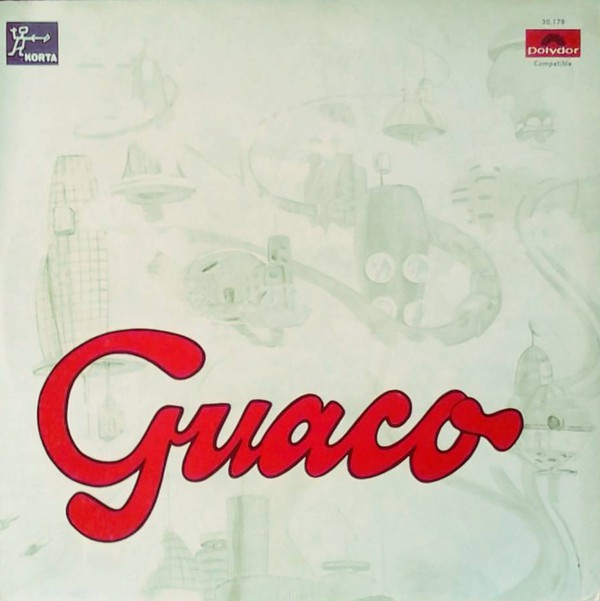
Side A
01- Que Nadie Se Mueva (Ricardo Hernández)
02- Remordimiento (Simón García)
03- Guaco-Soncito (Ricardo Portillo)
04- Juventud (Simón García)
05- La Negrita (R. Portillo/S. García)
06- Sueño Gaitero (Nerio Franco)
Side B
01- Barbaridad (Ricardo Hernández)
02- Gaita Siempre Seras Gaita (R. Portillo/S. García)
03- Los Viejitos (Ricardo Hernández)
04- Contaminación (Simón García)
05- Niche Parrandero Nº2 (Nerio Franco)
06- Tumbaito (Ricardo Portillo)
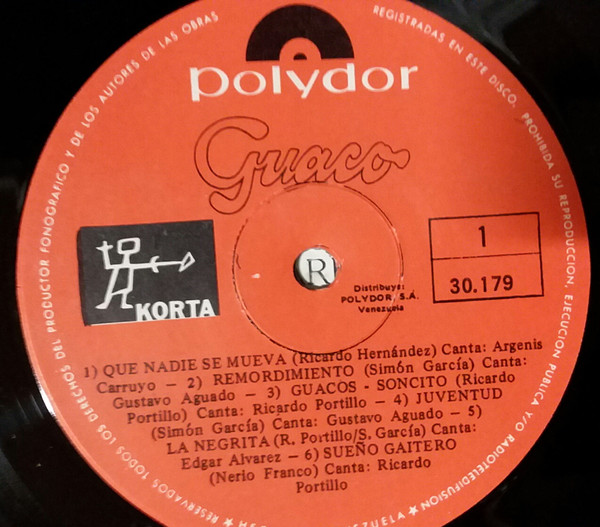
Personnel:
Vocals: Argenis Carruyo (tracks A1, B2), Gustavo Aguado (track A2, A4, B1, B4), Ricardo Portillo (tracks A3, A6, B3, B6), Edgar Alvarez (tracks A5, B5)
Tambora: Eudomar Peralta & Luis Rincón
Tumbadora & Backing Vocals: Ricardo Hernández
Furro: Alfonzo Aguado
Piano, Guitar & Cuatro: Nerio Franco
Cuatro & Backing Vocals: José Castillo
Bass: Carlos Sanchez
Charrasca: Alexis Moreno
Backing Vocals: Simón García & Heberto Bracho
The Guaco 75 marks the arrival of both Ricardo Portillo (who had come over from Cardenales del Éxito) and his songwriting partner Simón García. They would gain considerable influence within the group and its songwriting flavor over the next few releases. From three furros, we are now down to just one. Argenis Carruyo returns and sings "Gaita Siempre Serás Gaita" which was awarded Gaita of the year in 1975.
Que Nadie Se Mueva recieved a couple of remakes in 1989 and 2003 and became a live setlist staple for years in both ocassions. Barbaridad ups the ante and becomes a scorcher from the get-go. The rest of the album is a bit of a step down, quality wise.
1976 - Guaco 76 - Polydor/Korta/Velvet
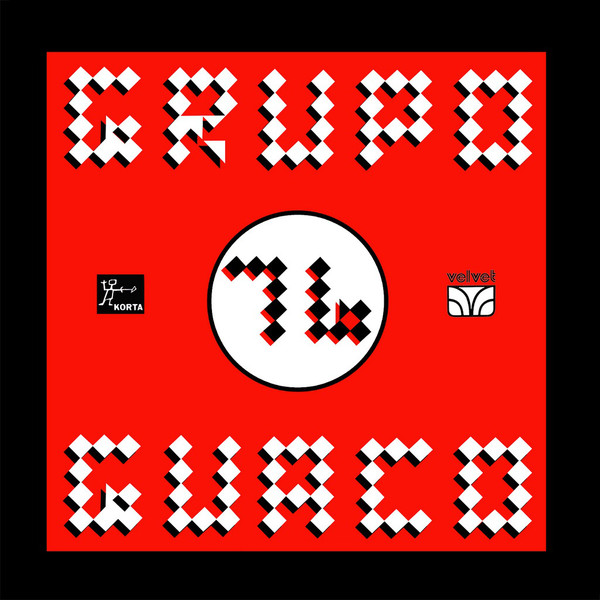
Side A
01- Con La Punta 'el Pie (Ricardo Hernández)
02- María La Bollera (Simón García)
03- Arrepentimiento (Ricardo Portillo)
04- Gaita Mía (Ricardo Portillo)
05- De Pasito a Pasito (Ricardo Portillo)
Side B
01- Gaita Bonita (Ricardo Hernández)
02- Guaco En Plena (Ricardo Hernández/Ricardo Portillo)
03- Remembranza (Grupo Guaco)
04- Simoncito (Simón García)
05- Son y Parranda (Ricardo Portillo)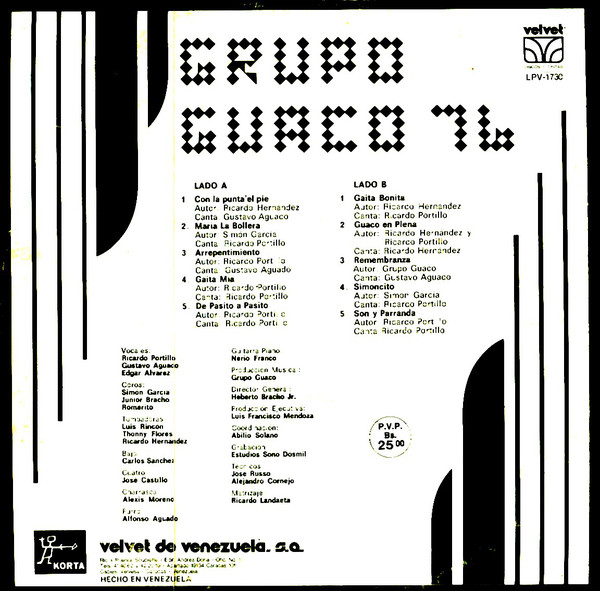
Vocals: Gustavo Aguado (track A1, A3, B3)
Ricardo Portillo (tracks A2, A4, A5, B1, B4, B5)
Ricardo Hernández (track B2)
Tambora: Luis Rincón & Yonis Flores
Tumbadora: Ricardo Hernández
Bass: Carlos Sánchez
Cuatro: José Castillo
Furro: Alfonzo Aguado
Charrasca: Alexis Moreno
Piano & Guitar: Nerio Franco
Backing Vocals: Simón García, Junior Bracho & Romerito
María La Bollera, a crude food-sex novelty song about a street vendor who sells food (and presumably other things) was Guaco's first nationwide hit. They were struggling mightily before and this song -sketchy and one-note as it might be- helped them gain some recognition and join the upper tier of gaita groups. The rest of the album finds them regaining some songwriting mojo. Con La Punta El Pie shares a title with the Issac barnburner and is just as aggressive. Arrepentimiento is their finest (and funniest) anti-drug song. Gaita Bonita is exactly what it says on the tin and Guaco En Plena, ditto. Also worthty of mention: Nerio Franco departs after this album.
1977 - Guaco 77 - Polydor/Korta/Jaguar
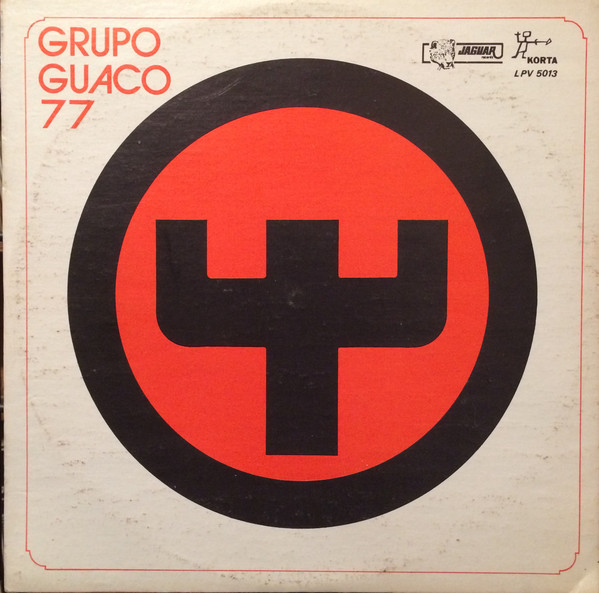
Side A
01- María Aumento El Negocio (Simón García)
02- Guaco Es Diferente (Ricardo Portillo)
03- Vagabundo (Simón García)
04- A Guarachar (Ricardo Blanco)
05- Reflexión (Simón García)
Side B
01- Recordando (Simón García)
02- Sabor A Guaco (Ricardo Portillo)
03- Si Compadre (Ricardo Hernández)
04- La Clave (Ricardo Hernández)
05- Los Venezolanos (Ricardo Portillo)
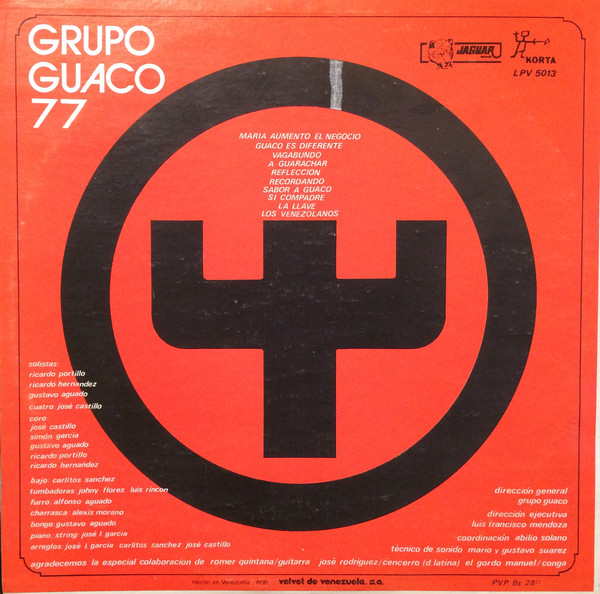
Personnel:
Vocals: Gustavo Aguado (tracks A2, A3, A5, B3)
Ricardo Portillo (tracks A1, B1, B2, B4, B5)
Ricardo Hernández (track A4)
Cuatro: José Castillo
Bass: Carlos Sánchez
Tambora: Yonis Flores & Luis Rincón
Furro: Alfonzo Aguado
Charrasca: Alexis Moreno
Bongo: Gustavo Aguado
Piano & Strings: José Luis García
Backing Vocals: José Castillo, Simón García, Gustavo Aguado,
Ricardo Portillo & Ricardo Hernández
Guest Musicians:
Guitar: Romer Quintero
Cowbell: José Rodríguez (from La Dimensión Latina)
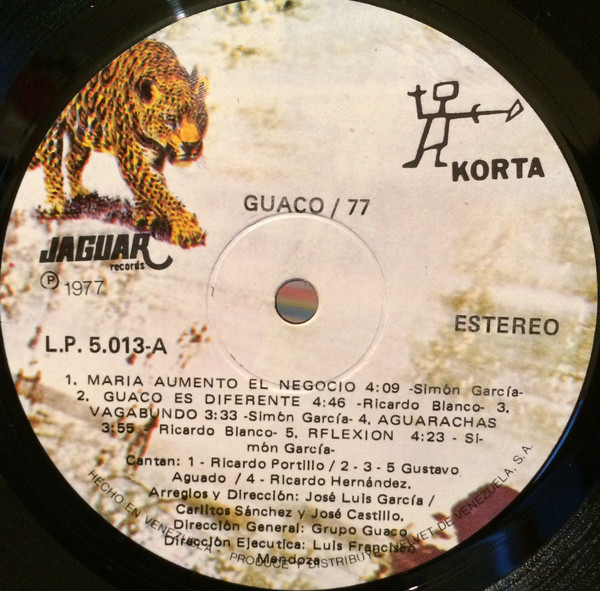
Guaco 77 sees the band adding a full-time piano player in José Luis García, who not only plays piano but also a very prog-sounding strings ensemble. Before his arrival Nerio Franco was the utility player and he would switch between cuatro, piano and guitar, depending on the song. The band also had the brilliant idea of adding bongo to the main gaita marcha and the results are wondrous, amplifying the genre's afro heritage.
María Aumentó El Negocio is the inevitable sequel to María La Bollera, with the police getting involved in the new offering. Guaco es Diferente is yet another classic tamborera that turns into a montuno halfway through. The band had the unofficial name of "La Mitad" for these kinds of arrangements. A Guarachar is Guaco's first orchestrared guaguancó.
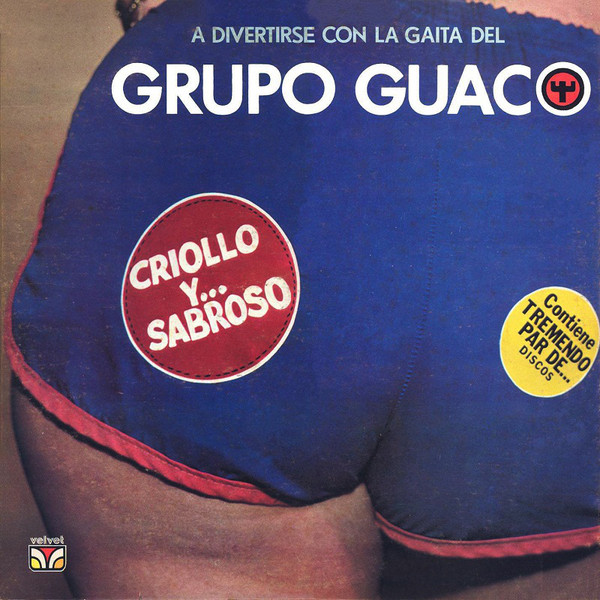
Disc1
Side A
01- Aguinaldo Maracucho (Simón García/Ricardo Portillo)
02- La Brollera (Simón García/Ricardo Portillo)
03- Criollo y Sabroso (José Castillo)
04- Una Tumba y Un Bongó (Ricardo Hernández)
Side B
01- Con Los Guaco No Hay Quien Pueda (Ricardo Hernández)
02- Tremenda Negra (Ricardo Hernández)
03- La Carta (Simón García)
04- Nada Contigo (Simón García/Ricardo Portillo)
Disc2
Side C
01- Gaitas Para Todos (Ricardo Hernández)
02- Eterno Amigo (Simón García/Ricardo Portillo)
03- Tú Mi Gaita (Romer Quintero)
04- El Swing De Guaco (Simón García/Ricardo Portillo)
Side D
01- Chistes (Ricardo Portillo)
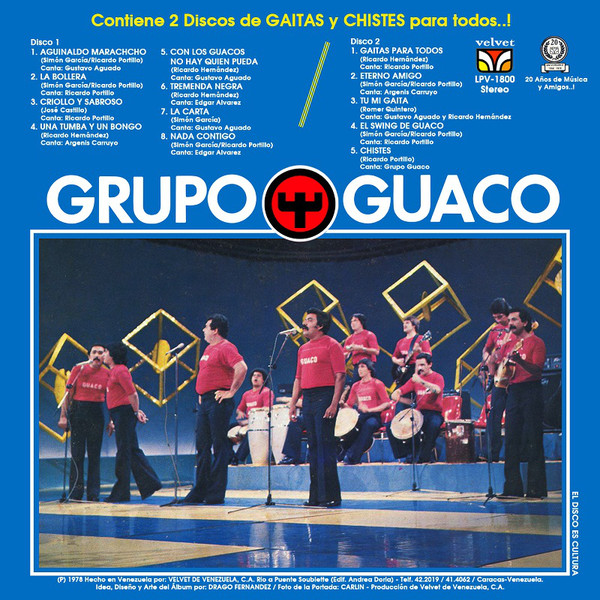
Vocals: Gustavo Aguado (tracks A1, B1, B3, C3)
Ricardo Portillo (tracks A2, A3, C1, C4)
Argenis Carruyo (tracks A4, C2)
Edgar Alvarez (tracks B2, B4)
Ricardo Hernández (track C3)
Tamboras: Luis Rincón, Yonis Flores & Ricardo Hernández
Congas, Cowbell & Charrasca: Ricardo Hernández
Bongo & Cowbell: Gustavo Aguado
Furro: Alfonso Aguado
Charrasca: Alexis Moreno
Piano & Strings: José Luís García
Cuatro: José Castillo
Guitar: Salvador Baglieri
Bass: Carlos Sánchez
Backing Vocals: Simón García, Romer Quintero, José Luís García
Ricardo Hernández & José Castillo
A Double Album! One of the first of its kind, surely. In reality, it's really one and a half sides worth of music with the final side being occupied by jokes, which is somehow even weirder. Probably seemed a good idea at the time. Aguinaldo Maracucho is hardcore gaita. Una Tumba y Un Bongó is yet another tamborera-guaguancó.
The band also added a full time guitarist in Salvador Baglieri who surely liked to use his fuzz pedal. Groovy.
Con Los Guaco No Hay Quien Pueda and Tremenda Negra, both by Ricardo Hernández, also became staples of their set for years to come.
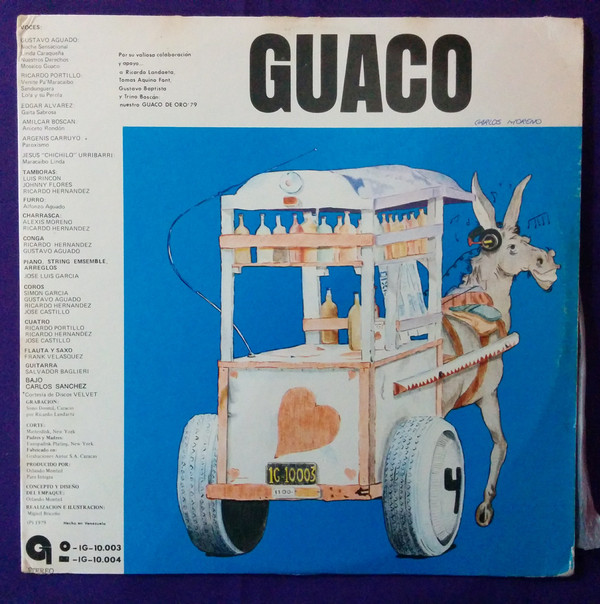
Side A
01- Sandunguera (Ricardo Hernández)
02- Noche Sensacional (Ricardo Hernández/José L. Suárez)
03- Maracaibo Linda (Simón García/Ricardo Portillo)
04- Homenaje a Aniceto Rondón (Ricardo Hernández/G. Cohen)
05- Mosaico Guaco (Marío Viloria)
Side B
01- Venite Pa' Maracaibo (Ricardo Hernández)
02- Linda Caraqueña (R. Hernández/G. Aguado/R. Portillo)
03- Paroxismo (Simón García/Ricardo Portillo)
04- Lola y Su Perola (Simón García)
05- Gaita Sabrosa (Ricardo Hernández)
06- Nuestro Derecho (Simón García)
Personnel:
Vocals: Gustavo Aguado (tracks A2, A5, B2, B6)
Ricardo Portillo (tracks A1, B1, B4)
Edgar Alvarez (track B5)
Amilcar Boscán (track A4)
Argenis Carruyo (track B3)
Jesús Urribarri (track A3)
Tamboras: Luis Rincón, Yonis Flores & Ricardo Hernández
Furro: Alfonso Aguado
Charrasca: Alexis Moreno & Ricardo Hernández
Conga: Ricardo Hernández & Gustavo Aguado
Piano & Strings: José Luis García
Backing Vocals: Simón García, Gustavo Aguado,
Ricardo Hernández & José Castillo
Flute & Sax: Frank Velásquez
Guitar: Salvador Baglieri
The last album of the 70s sees the band adding a single reed player. The unison sax and guitar lines throughout this album are worthy of mention. They would become useful for future mambo passages.
Venite Pa Maracaibo became a gaita staple, probably played every year by covers bands throughout the city. Paroxismo is a soulful and romantic gaita, a relative rarity, sung with aplomb by Argenis Carruyo. Noche Sensacional still gets played by the band to this band and was covered by the great Cheo Feliciano in 1982. Amilcar Boscán joins and sings the great Homenaje A Aniceto Rondón, which is a gaita so old, it was considered old when back in 1979. The band also does an oldies medley in homage to Mario Viloria.

















